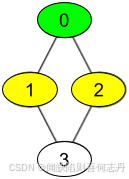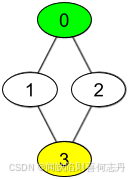本文涉及知识点
LeetCode1311. 获取你好友已观看的视频
有 n 个人,每个人都有一个 0 到 n-1 的唯一 id 。
给你数组 watchedVideos 和 friends ,其中 watchedVideos[i] 和 friends[i] 分别表示 id = i 的人观看过的视频列表和他的好友列表。
Level 1 的视频包含所有你好友观看过的视频,level 2 的视频包含所有你好友的好友观看过的视频,以此类推。一般的,Level 为 k 的视频包含所有从你出发,最短距离为 k 的好友观看过的视频。
给定你的 id 和一个 level 值,请你找出所有指定 level 的视频,并将它们按观看频率升序返回。如果有频率相同的视频,请将它们按字母顺序从小到大排列。
示例 1:

输入:watchedVideos = [[“A”,“B”],[“C”],[“B”,“C”],[“D”]], friends = [[1,2],[0,3],[0,3],[1,2]], id = 0, level = 1
输出:[“B”,“C”]
解释:
你的 id 为 0(绿色),你的朋友包括(黄色):
id 为 1 -> watchedVideos = [“C”]
id 为 2 -> watchedVideos = [“B”,“C”]
你朋友观看过视频的频率为:
B -> 1
C -> 2
示例 2:
输入:watchedVideos = [[“A”,“B”],[“C”],[“B”,“C”],[“D”]], friends = [[1,2],[0,3],[0,3],[1,2]], id = 0, level = 2
输出:[“D”]
解释:
你的 id 为 0(绿色),你朋友的朋友只有一个人,他的 id 为 3(黄色)。
提示:
n == watchedVideos.length == friends.length
2 <= n <= 100
1 <= watchedVideos[i].length <= 100
1 <= watchedVideos[i][j].length <= 8
0 <= friends[i].length < n
0 <= friends[i][j] < n
0 <= id < n
1 <= level < n
如果 friends[i] 包含 j ,那么 friends[j] 包含 i
题解
一,通过BFS求出第leve 层朋友。
二,利用哈希映射mVideoCnt记录leve层朋友看的视频及次数。
三,有序映射sCntVideo记录:观看次数、视频名称。
四,按sCntVideo顺序返回视频名称。
BFS的状态表示:leves[0] = {id},leves[i]记录leves[i-1]的直接朋友。
BFS的状态表示:通过next枚举cur的直接朋友。
BFS的初始状态:leves[0] = {id}
BFS的返回值:leves[leve]
BFS的出重处理:数组vis出重。
代码
核心代码
class Solution { public: vector<string> watchedVideosByFriends(vector<vector<string>>& watchedVideos, vector<vector<int>>& friends, int id, int level) { const int N = watchedVideos.size(); vector<vector<int>> leves = { {id} }; vector<bool> vis(N); vis[id] = true; for (int i = 0; i < leves.size(); i++) { vector<int> nexts; for (const auto& cur : leves[i]) { for (const auto& next : friends[cur]) { if (vis[next]) { continue; } vis[next] = true; nexts.emplace_back(next); } } if (nexts.empty()) { break; } leves.emplace_back(nexts); } if (level >= leves.size()) { return {}; }; unordered_map<string, int> mVideoCnt; for (const auto& i : leves[level]) { for (const auto& s : watchedVideos[i]) { mVideoCnt[s]++; } } set<pair<int, string>> sCntVideo; for (const auto& [s, cnt] : mVideoCnt) { sCntVideo.emplace(cnt, s); } vector<string> ret; for (const auto& [tmp, s] : sCntVideo) { ret.emplace_back(s); } return ret; } }; 单元测试
vector<vector<string>> watchedVideos; vector<vector<int>> friends; int id, level; TEST_METHOD(TestMethod1) { watchedVideos = { {"A","B"},{"C"},{"B","C"},{"D"} }, friends = { {1,2,3},{},{},{} }, id = 0, level = 2; auto res = Solution().watchedVideosByFriends(watchedVideos, friends, id, level); AssertEx(vector<string>{}, res); } TEST_METHOD(TestMethod2) { watchedVideos = { {"A"},{"B"},{"C"},{"D"} }, friends = { {1},{2},{3},{} }, id = 0, level = 2; auto res = Solution().watchedVideosByFriends(watchedVideos, friends, id, level); AssertEx(vector<string>{"C"}, res); } TEST_METHOD(TestMethod3) { watchedVideos = { {"A","B"},{"A"},{"B"},{"A"} }, friends = { {1,2,3},{},{},{} }, id = 0, level = 1; auto res = Solution().watchedVideosByFriends(watchedVideos, friends, id, level); AssertEx(vector<string>{"B","A"}, res); } TEST_METHOD(TestMethod4) { watchedVideos = { {"A","B"},{"A"},{"B"},{"B"} }, friends = { {1,2,3},{},{},{} }, id = 0, level = 1; auto res = Solution().watchedVideosByFriends(watchedVideos, friends, id, level); AssertEx(vector<string>{"A", "B"}, res); } TEST_METHOD(TestMethod5) { watchedVideos = { {"A","B"},{"A"},{"B"},{"C"} }, friends = { {1,2,3},{},{},{} }, id = 0, level = 1; auto res = Solution().watchedVideosByFriends(watchedVideos, friends, id, level); AssertEx(vector<string>{"A", "B","C"}, res); } TEST_METHOD(TestMethod6) { watchedVideos = { {"A","B"},{"A"},{"C"},{"B"} }, friends = { {1,2,3},{},{},{} }, id = 0, level = 1; auto res = Solution().watchedVideosByFriends(watchedVideos, friends, id, level); AssertEx(vector<string>{"A", "B", "C"}, res); } TEST_METHOD(TestMethod11) { watchedVideos = { {"A","B"},{"C"},{"B","C"},{"D"} }, friends = { {1,2},{0,3},{0,3},{1,2} }, id = 0, level = 1; auto res = Solution().watchedVideosByFriends(watchedVideos, friends, id, level); AssertEx(vector<string>{"B", "C"}, res); } TEST_METHOD(TestMethod12) { watchedVideos = { {"A","B"},{"C"},{"B","C"},{"D"} }, friends = { {1,2},{0,3},{0,3},{1,2} }, id = 0, level = 2; auto res = Solution().watchedVideosByFriends(watchedVideos, friends, id, level); AssertEx(vector<string>{"D"}, res); } 
扩展阅读
| 我想对大家说的话 |
|---|
| 工作中遇到的问题,可以按类别查阅鄙人的算法文章,请点击《算法与数据汇总》。 |
| 学习算法:按章节学习《喜缺全书算法册》,大量的题目和测试用例,打包下载。重视操作 |
| 有效学习:明确的目标 及时的反馈 拉伸区(难度合适) 专注 |
| 闻缺陷则喜(喜缺)是一个美好的愿望,早发现问题,早修改问题,给老板节约钱。 |
| 子墨子言之:事无终始,无务多业。也就是我们常说的专业的人做专业的事。 |
| 如果程序是一条龙,那算法就是他的是睛 |
| 失败+反思=成功 成功+反思=成功 |
视频课程
先学简单的课程,请移步CSDN学院,听白银讲师(也就是鄙人)的讲解。
https://edu.csdn.net/course/detail/38771
如何你想快速形成战斗了,为老板分忧,请学习C#入职培训、C++入职培训等课程
https://edu.csdn.net/lecturer/6176
测试环境
操作系统:win7 开发环境: VS2019 C++17
或者 操作系统:win10 开发环境: VS2022 C++17
如无特殊说明,本算法用**C++**实现。

